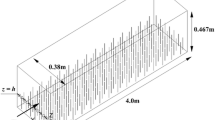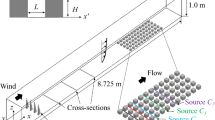Abstract
The computational method of Large-Eddy Simulations has been used to study the weak, neutrally stable drainage flow within tree canopies. The computational results show that a secondary velocity maximum that resembles a jet is formed within the canopy under the nocturnal flow conditions. This jet-like flow is important in the analysis and measurements of the net ecosystem-atmosphere exchange (NEE) for carbon dioxide (CO2). A uniformly distributed, plane source was placed within the canopy in order to simulate the nocturnal production of CO2. The NEE is calculated as the sum of the integration of the rate of change of the concentration of CO2 over the computational domain, the vertical turbulent flux measured directly by eddy-covariance (EC) method, and the advection terms, which are not taken into account in the EC method. Numerical results of the velocity and concentration fields, within and above the canopy, are presented and their impact on the CO2 transport is investigated in detail. The computational results show that 15–20% of NEE is drained out by the advection process under the canopy. The results also show that the turbulent fluctuations in the lateral direction are also significant and may result in 2–5% CO2 transport.
Similar content being viewed by others
References
Amiro BD (1990) Comparison of turbulence statistics within 3 boreal forest canopies. Bound-Lay Meteorol 51:99–121
Andren A (1995) The structure of stably stratified atmospheric boundary layers: a large-eddy simulation study. Q J R Meteorol Soc 121:961–985
Aubinet M, Heinesch B, Yernaux M (2003) Horizontal and vertical CO2 advection in a sloping forest. Bound-Lay Meteorol 108:397–417
Baldocchi DD, Meyers TP (1998) Turbulence structure in a deciduous forest. Bound-Lay Meteorol 43:345–364
Baldocchi DD, Meyers TP (1991) Trace gas exchange at the floor of a deciduous forest I. Evaporation and CO2 efflux. J Geophys Res 96:7271–7285
Bakwin PS, Davis KJ, Yi C, Wofsy SW, Munger JW (2004) Regional carbon dioxide flues from mixing ratio data. Tellus 56B:301–311
Cava D, Giostra U, Siqueria M, Katul GG (2004) Organized motion and radiative perturbations in the nocturnal canopy sublayer above an even-aged pine forest. Bound-Lay Meteorol 112:129–154
Cionco RM (1965) A mathematical model for air flow in a vegetative canopy. J Appl Meteorol 4:517–522
Coppin PA, Raupach MR, Legg BJ (1986) Experiments on scalar dispersion within a model plant canopy. Part II: An elevated plant source. Bound-Lay Meteorol 35:167–191
Deardorff JW (1980) Stratocumulus-capped mixed layers derived from a three-dimensional model. Boundary-Layer Meteorol 18:495–527
Ding F, Arya SP, Lin YL (2001) Large-eddy simulation of the atmospheric boundary layer using a new subgrid-scale model. Environ Fluid Mech 1:49–69
Finnigan J (2000) Turbulence in plant canopies. Annu Rev Fluid Mech 32:519–571
Finnigan J (1999) A comment on the paper by Lee (1998): on micrometeorological observations of surface-air exchange over tall vegetation. Agric For Meteorol 97:43–69
Fitzmaurice Li, Shaw RH, Paw U KT, Patton EG (2004) Three-dimensional scalar microfront systems in a large-eddy simulation of vegetation canopy flow. Bound-Lay Meteorol 112:107–127
Glauert MB (1956) The wall jet. J Fluid Mech 1:625–643
Galmarini S, Beets C, Duynkerke PG, Vila-Guerau de J (1998) Stable nocturnal boundary layers: a comparison of one-dimensional and large-eddy simulation models. Bound-Lay Meteorol 88:181–210
Garratt JR (1992) The atmospheric boundary layer. Cambridge University Press, Cambridge, pp 316
Gross G (1993) Numerical simulation of canopy flows. Springer-Verlag, Berlin, pp 168
Gu L, Shugart HH, Fuentes JD, Black TA, Shewchuk SR (1999) Micrometeorology, biophysical exchange and NEE decomposition in a two-story boreal forest-development and test of an integrated model. Agricul For Meteorol 94:123–148
Jimenez MA, Cuxart J (2005) Large-eddy simulation of the stable boundary layer using the standard kolmogorov theory: range of application. Bound-Lay Meteorol 115:241–261
Katul GG, Albertson JD (1998) An investigation of higher-order closure models for a forest canopy. Bound-Lay Meteorol 89:47–74
Katul GG, Leuning R, Kim J, Denmead OT, Miyata A, Harazono Y (2001) Estimation CO2 source/sink distributions within a rice canopy using high-order closure model. Bound-Lay Meteorol 98:103–125
Kelliher FM et al (1998) Evaporation from a central Siberian pine forest. J Hydro 205:279–296
Lai CT, Katul G, Ellsworth D, Oren R (2000) Modelling vegetation-atmosphere CO2 exchange by a coupled Eulerian-Langrangian approach. Bound-Lay Meteorol 95:91–122
Lee X (1998) On micrometeorological observations of surface-air exchange over tall vegetation. Agric For Meteorol 91:39–49
Mahrt L (1982) Momentum balance of gravity flows. J Atmos Sci 39:2701–2711
Mahrt L, Vickers D, Nakamura R, Soler MR, Sun J, Burns S, Lenschow DH (2001) Shallow drainage flow. Bound-Lay Meteorol 101:243–260
Mason PJ, Derbyshire SH (1990) Large-eddy simulation of the stably-stratified atmospheric boundary layer. Bound-Lay Meteorol 53:117–162
Meyers TP, Paw U KT (1986) Testing of a higher-order closure model for modeling airflow within and above plant canopies. Bound-Lay Meteorol 37:297–311
Moeng C-H (1984) A large-eddy-simulation model for the study of planetary boundary-layer turbulence. J Atmos Sci 41(13):2052–2062
Nepf HM, Vivoni ER (2000) Flow structure in depth-limited vegetation flow. J Geophy Res (Oceans) 105:28547–28557
Nieuwstadt FTM (1984) The turbulent structure of the stable, nocturnal boundary layer. J Atmos Sci 41:2202–2216
Panofsky HA, Dutton JA (1984) Atmospheric turbulence: models and methods for engineering applications. Wiley, New York
Patton EG, Shaw RH, Judd MJ, Raupach MR (1998) Large-eddy simulation of windbreak flow. Bound-Lay Meteorol 87:275–306
Paw U KT, Baldocchi DD, Meyers TP, Wilson L (2000) Correction of eddy-covariance measurements incorporating both advective effects and density fluxes. Bound-Lay Meteorol 97:487–511
Raupach MR (1988) Canopy transport processes. In: Steffer WL, Denmead OT (eds) Flow and transport in the natural environment: advances and application. Springer-Verlag, Berlin, pp. 95–127
Raupach MR, Thom AS (1981) Turbulence in and above plant canopies. Annu Rev Fluid Mech 13:97–129
Saiki EM, Moeng C-.H, Sullivan PP (2000) Large-eddy simulation of the stably stratified planetary boundary layer. Bound-Lay Meteorol 95:1–30
Seffal R, Michaelides EE (1996) Similarity solutions for a turbulent round jet. J Fluids Eng 118:618–622
Shaw RH (1977) Secondary wind speed maxima inside plant canopies. J Appl Meteorol. 16:514–521
Shaw RH, Schumann U (1992) Large-eddy simulation of turbulent flow above and within a forest. Bound-Lay Meteoro.l 61:47–64
Shaw RH, Seginer I (1985) The dissipation of turbulence in plant canopies. In: 7th symposium of the American meteoriological society on turbulence and diffusion. Boulder, Colorado, pp 200–203
Shaw RH, Hortog GD, Neumann HH (1988) Influence on foliar density and thermal stability on profile of Reynolds stress and turbulence intensity in a deciduous forest. Bound-Lay Meteorol 45:391–409
Shen S, Leclerc MY (1997) Modelling the turbulence structure in the canopy layer. Agric For Meteorol 87:3–25
Sogachev A, Lloyd J (2004) Using a one-and-a-half order closure model of the atmospheric boundary layer for surface flux footprint estimation. Bound-Lay Meteorol 112:467–502
Staebler RM, Fitzjarrald DR (2004) Observing subcanopy CO2 advection. Agric For Meteorol 122:139–156
Su HB, Shaw RH, Paw U KT (2000) Two-point correlation analysis of neutrally stratified flow within and above a forest from large-eddy simulation. Bound-Lay Meteorol 94:423–460
Sullivan PP, Williams JC, Meong C-H (1994) A subgrid-scale model for large-eddy simulation of planetary boundary-layer flows. Bound-Lay Meteorol 71:247–276
Verma SB, Baldocchi DD, Anderson DE, Matt DR, Clement RJ (1986) Eddy fluxes of CO2, water vapor, and sensitive heat over a deciduous forest. Bound-Lay Meteorol 36:71–91
Vinkovic I, Aguirre C, Simoens S (2006) Large-eddy simulation and Lagrangian stochastic modeling of passive scalar dispersion in a turbulent boundary layer. J Turbul 7:030
Wilson JD (1988) A 2nd-order closure-model for flow through vegetation. Bound-Lay Meteorol 42:371–392
Wilson NR, Shaw RH (1977) A higher order closure model for canopy flow. J Appl Meteorol 16:1198–1205
Xie Z, Hayden P, Voke PR, Robbins AG (2004) Large-eddy simulation of dispersion: comparison between elevated and ground-level sources. J Turbul 5:031
Yang B, Raupach MR, Shaw RH, Paw U KT, Morse AP (2006) Large-eddy simulation of turbulent flow across a forest edge. Part I: flow statistics. Bound-Lay Meteorol 120:377–412
Yi C, Anderson DE, Turnipseed AA, Burns SP, Sparks JP, Stannard D, Monson RK (2006) The contribution of advection fluxes to net ecosystem CO2 exchange in a high-evelation, subalpine forest ecosystem. to appear in Ecol Appl
Yi C, Davis KJ, Bakwin PS, Berger BW, Marr LC (2000) Influence of advection on measurement of the net ecosystem-atmosphere exchange of CO 2 from a very tall tower. J Geophysical Research 105:9991–9999
Yi C, Monson RK, Zhai Z, Anderson DE, Lamb B, Allwine G, Turnipseed AA, Burns SP (2005) Modeling and measuring the nocturnal drainage flow in a high-elevation, subalpine forest with complex terrain. J Geophys Res 110:D22303
Author information
Authors and Affiliations
Corresponding author
Rights and permissions
About this article
Cite this article
Mao, S., Feng, Z.G. & Michaelides, E.E. Large-eddy simulation of low-level jet-like flow in a canopy. Environ Fluid Mech 7, 73–93 (2007). https://doi.org/10.1007/s10652-006-9014-3
Received:
Accepted:
Published:
Issue Date:
DOI: https://doi.org/10.1007/s10652-006-9014-3




